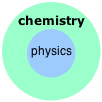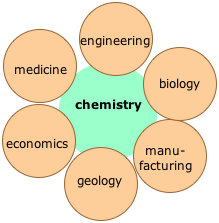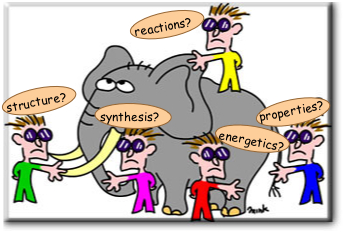Matter - is “anything that has mass and occupies space”, we were taught in school. True enough, but not very satisfying. A more complete answer is unfortunately far beyond the scope of this course, but we will offer a hint of it in the later section on atomic structure. For the moment, let’s side-step definition of matter and focus on the chemist’s view: matter is what chemical substances are composed of. But what do we mean by chemical substances? How do we organize our view of matter and its properties? These will be the subjects of this lesson.
Matter - is a general term for the substance of which all physical objects consist. Typically, matter includes atoms and other particles which have mass. A common way of defining matter is as anything that has mass and occupies volume. However, different fields use the term in different and sometimes incompatible ways; there is no single agreed scientific meaning of the word "matter".
Observable properties of matter
The science of chemistry developed from observations made about the nature and behavior of different kinds of matter, which we refer to collectively as the properties of matter.
The properties we refer to in this lesson are all macroscopic properties: those that can be observed in bulk matter. At the microscopic level, matter is of course characterized by its structure: the spatial arrangement of the individual atoms in a molecular unit or an extended solid.
The study of matter begins with the study of its properties
By observing a sample of matter and measuring its various properties, we gradually acquire enough information to characterize it; to distinguish it from other kinds of matter. This is the first step in the development of chemical science, in which interest is focused on specific kinds of matter and the transformations between them.
Extensive and Intensive properties
Intensive - Properties that do not depend on the amount of the matter present.
· Color
· Odor
· Luster - How shiny a substance is.
· Malleability - The ability of a substance to be beaten into thin sheets.
· Ductility - The ability of a substance to be drawn into thin wires.
· Conductivity - The ability of a substance to allow the flow of energy or electricity.
· Hardness - How easily a substance can be scratched.
· Melting/Freezing Point - The temperature at which the solid and liquid phases of a substance are in equilibrium at atmospheric pressure.
· Boiling Point - The temperature at which the vapor pressure of a liquid is equal to the pressure on the liquid (generally atmospheric pressure).
· Density - The mass of a substance divided by its volume 
Extensive - Properties that do depend on the amount of matter present.
· Mass - A measurement of the amount of matter in a object (grams).
· Weight - A measurement of the gravitational force of attraction of the earth acting on an object.
· Volume - A measurement of the amount of space a substance occupies.
· Length
Classify each of the following as an extensive or intensive property.
1. The volume of beer in a mug
2. The percentage of alcohol in the beer
3. The number of calories of energy you derive from eating a banana
4. The number of calories of energy made available to your body when you consume 10.0 g of sugar
5. The mass of iron present in your blood
6. The mass of iron present in 5 mL of your blood
7. The electrical resistance of a piece of 22-gauge copper wire.
8. The electrical resistance of a 1-km length of 22-gauge copper wire
9. The pressure of air in a bicycle tire
Classification of Matter
| Matter Anything with mass and volume. | |||
| Substance Matter with constant composition | Mixture Matter with variable composition | ||
| Element Substance made up of only one type of atom | Compound Two or more elements that are chemically combined | Heterogeneous Mixture Mixtures that are made up of more than one phase | Homogeneous Mixtures Also called solutions. Mixtures that are made up of only one phase |
| Examples - gold, silver, carbon, oxygen and hydrogen | Examples - water, carbon dioxide, sodium bicarbonate, carbon monoxide | Examples - sand, soil, chicken soup, pizza, chocolate chip cookies. | Examples - salt water, pure air, metal alloys, seltzer water. |
Operational and conceptual classifications
Since chemistry is an experimental science, we need a set of experimental criteria for placing a given sample of matter in one of these categories. There is no single experiment that will always succeed in unambiguously deciding this kind of question. However, there is one principle that will always work in theory, if not in practice. This is based on the fact that the various components of a mixture can, in principle, always be separated into pure substances.
Consider a heterogeneous mixture of salt water and sand. The sand can be separated from the salt water by the mechanical process of filtration. Similarly, the butterfat contained in milk may be separated from the water by a mechanical process known as centrifugation, which depends on differences in density between the two components. These examples illustrate the general principle that heterogeneous matter may be separated into homogeneous matter by mechanical means. Turning this around, we have an operational definition of heterogeneous matter: if, by some mechanical operation we can separate a sample of matter into two or more other kinds of matter, then our original sample was heterogeneous.
To find a similar operational definition for homogeneous mixtures, consider how we might separate the two components of a solution of salt water. The most obvious way would be to evaporate off the water, leaving the salt as a solid residue. Thus a homogeneous mixture can be separated into pure substances by undergoing appropriate changes of state— that is, by evaporation, freezing, etc. If a sample of matter remains unchanged by carrying out operations of this kind, then it could be a pure substance.
Some common methods of separating homogeneous mixtures into their components are outlined below.
Ø Distillation. A liquid is partly boiled away; the first portions of the condensed vapor will be enriched in the lower-boiling component.
Ø Fractional crystallization. A hot saturated solution of a solid in a liquid is allowed to cool slowly; the first solid that crystallizes out tends to be of higher purity.
Ø Liquid-liquid extraction. Two mutually-insoluble liquids, one containing two or more solutes (dissolved substances), are shaken together. Each solute will concentrate in the liquid in which it is more soluble.
Ø Chromatography. As a liquid or gaseous mixture flows along a column containing an adsorbant material, the more strongly-adsorbed components tend to move more slowly and emerge later than the less-strongly adsorbed components.
Physical and chemical properties
| Physical Changes | Chemical Changes |
| Changes in matter that do not alter the identity of the matter itself | Changes that do alter the identity of a substance. |
| Ø Size Ø Shape Ø State - solid Ø Dilutions | Ø Iron rusting Ø Wood burning Ø Copper turning to brass |
| Common Errors Ice melting, water freezing, water evaporating, and steam condensing are all examples of a state change. These are physical changes, not chemical. Diluting a solution is a physical change, even if the color becomes fainter. | |
Classify each of the statements as a physical or chemical property, and explain the basis for your answer.
| Chlorine is a greenish-yellow gas at room temperature. | |
| Liquid oxygen is attracted by a magnet. | |
| Gold is highly resistant to corrosion. | |
| Hydrogen cyanide is an extremely poisonous gas. | |
| Sugar is a high-energy food. | |


